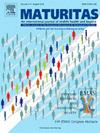Age at menarche in relation to risk of chronic obstructive pulmonary disease: Results from the China Kadoorie Biobank study of 300,000 Chinese women
IF 3.9
2区 医学
Q2 GERIATRICS & GERONTOLOGY
引用次数: 0
Abstract
Background
Age at menarche has important implications for lung function. However, little is known about its association with chronic obstructive pulmonary disease (COPD). The present study aims to investigate age at menarche in relation to the risk of COPD among Chinese women.
Methods
We analyzed data on 302,463 women aged 30–79 years from 10 regions across China during 2004 to 2008, recruited by the China Kadoorie Biobank baseline survey. Multivariable logistic regression was used to examine odds ratios (ORs) with 95 % confidence intervals (CIs) for the association between COPD and age at menarche.
Results
Overall, the average age at menarche was 15.4 ± 2.0 years. The relationship between age at menarche and adult COPD was J-shaped. Compared with women with menarche at age 13–14 years, the adjusted ORs for COPD for menarche at ≤12, 15–16, and ≥ 17 years of age were 1.21 (95 % CI: 1.07, 1.36), 1.04 (95 % CI: 0.98, 1.11) and 1.11 (95 % CI, 1.03, 1.19), respectively. The patterns of association appeared to be more pronounced among women living in rural areas and those who ever drank alcohol.
Conclusions
In Chinese adults, both early menarche and late menarche are associated with increased risk of COPD; as such, age at menarche may be a factor that could help to identify women at higher COPD risk who would benefit from early preventative strategies.
初潮年龄与慢性阻塞性肺病风险的关系:中国嘉道理生物数据库对 30 万中国女性的研究结果。
背景:初潮年龄对肺功能有重要影响。然而,人们对初潮年龄与慢性阻塞性肺疾病(COPD)的关系知之甚少。本研究旨在调查初潮年龄与中国女性罹患慢性阻塞性肺病风险的关系:我们分析了 2004 年至 2008 年期间通过中国嘉道理生物库基线调查从中国 10 个地区招募的 302,463 名 30-79 岁女性的数据。采用多变量逻辑回归来检验慢性阻塞性肺病与初潮年龄之间的几率比(ORs)及95%置信区间(CIs):总体而言,初潮年龄平均为 15.4 ± 2.0 岁。初潮年龄与成人慢性阻塞性肺病之间的关系呈 "J "形。与初潮年龄为 13-14 岁的女性相比,初潮年龄≤12 岁、15-16 岁和≥17 岁的女性患慢性阻塞性肺病的调整 OR 分别为 1.21(95 % CI:1.07,1.36)、1.04(95 % CI:0.98,1.11)和 1.11(95 % CI:1.03,1.19)。这种关联模式似乎在农村地区妇女和曾经饮酒的妇女中更为明显:结论:在中国成年人中,初潮早和初潮晚都与慢性阻塞性肺病的风险增加有关;因此,初潮年龄可能是一个有助于识别慢性阻塞性肺病高风险女性的因素,这些女性将受益于早期预防策略。
本文章由计算机程序翻译,如有差异,请以英文原文为准。
求助全文
约1分钟内获得全文
求助全文
来源期刊

Maturitas
医学-妇产科学
CiteScore
9.10
自引率
2.00%
发文量
142
审稿时长
40 days
期刊介绍:
Maturitas is an international multidisciplinary peer reviewed scientific journal of midlife health and beyond publishing original research, reviews, consensus statements and guidelines, and mini-reviews. The journal provides a forum for all aspects of postreproductive health in both genders ranging from basic science to health and social care.
Topic areas include:• Aging• Alternative and Complementary medicines• Arthritis and Bone Health• Cancer• Cardiovascular Health• Cognitive and Physical Functioning• Epidemiology, health and social care• Gynecology/ Reproductive Endocrinology• Nutrition/ Obesity Diabetes/ Metabolic Syndrome• Menopause, Ovarian Aging• Mental Health• Pharmacology• Sexuality• Quality of Life
 求助内容:
求助内容: 应助结果提醒方式:
应助结果提醒方式:


